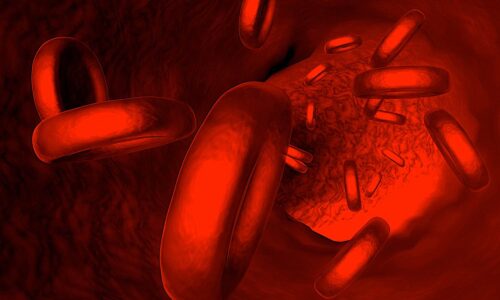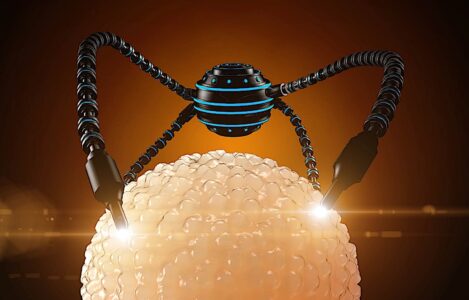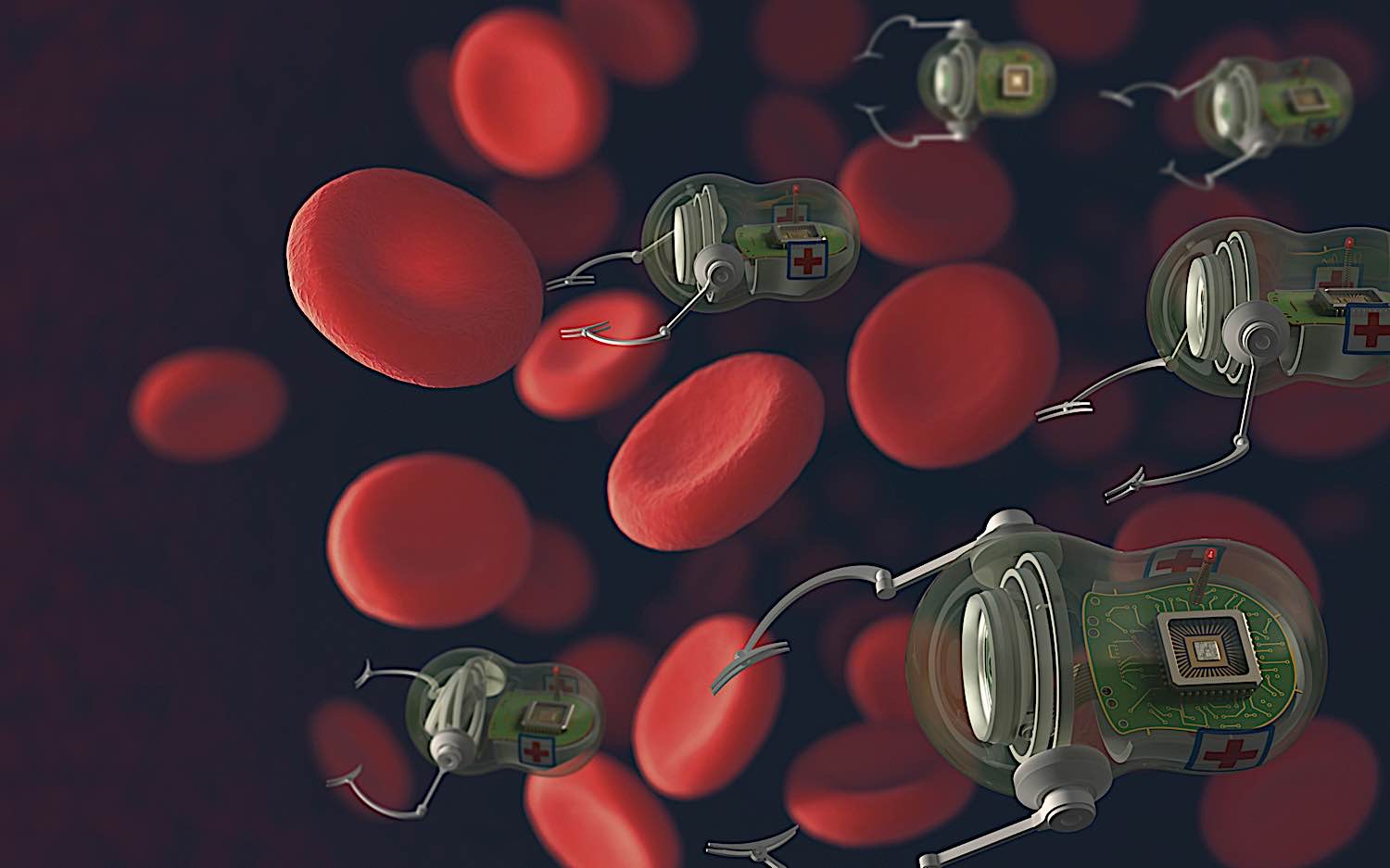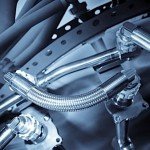A cutting-edge technology, inspired by the natural world, introduces a new potential for medical diagnostics and treatment. The marvels of nature continue to inspire ground-breaking innovations in science and technology, and the latest developments in robotics are impressive.
A recent breakthrough has led to the creation of an autonomous swimming micro-robot modeled after bacteria. This micro-robot can analyze and differentiate cells within the human body.
This fascinating innovation opens the door to a world of potential applications, from advanced diagnostics to targeted drug delivery. Keep reading as we delve into the features and applications of this micro-robotic innovation, which could revolutionize the world of medicine as we know it. We’ll also cover some challenges and ethical issues the micro-robot introduces.

Nature-inspired Engineered Design
The unique movement of bacteria directly influenced the engineered design of this autonomous swimming micro-robot.
Bacteria are known for their ability to swim through fluid environments using their flagella. These are long whip-like appendages that propel them forward. By mimicking this mode of movement, scientists have developed a micro-robot that can travel through the human bloodstream and access hard-to-reach areas in the body.
The micro-robot consists of soft, flexible, and biocompatible material, allowing it to safely navigate the body’s intricate systems without causing harm. Moreover, the robot’s microscopic size is comparable to that of bacteria. This will enable it to pass through the narrowest of blood vessels and explore the inner workings of our bodies with minimal intrusion.
This engineered design not only facilitates the robot’s movement but also expands its potential applications in medical diagnostics and treatment.

Advanced Cellular Analysis and Differentiation
One of the most exciting features of this autonomous swimming micro-robot is its ability to assess and differentiate cells within the human body.
Complete with cutting-edge sensors, the robot can identify various cell types and distinguish between healthy and diseased cells. This remarkable capability has significant implications for the early detection of a wide range of diseases, including cancer, autoimmune disorders, and infections.
The micro-robot’s advanced sensing technology also allows it to detect specific biomarkers linked with certain medical conditions. As a result, it can provide healthcare professionals with critical information about people’s health status for more accurate diagnoses and personalized treatment plans.
Targeted Drug Delivery
Beyond diagnostics, the autonomous swimming micro-robot also holds great promise for revolutionizing drug delivery methods.
Traditional drug delivery systems often struggle to reach specific target sites within the body. This can lead to reduced efficacy and potential side effects caused by the drug’s distribution to non-target areas.
The micro-robot, however, can travel directly to the intended site, ensuring that the drug is administered accurately and efficiently. Not only that, but the micro-robot’s ability to differentiate between cell types means it can deliver drugs exclusively to diseased cells while sparing healthy ones.
This targeted approach not only improves treatment efficacy but also reduces the risk of adverse side effects. This leads to better patient outcomes and overall quality of life.
This targeted drug delivery system could be a game-changer for cancer treatment, as it would allow for the delivery of chemotherapy drugs straight to tumor cells while reducing damage to healthy tissue.

Real-time Monitoring and Data Collection
The autonomous swimming micro-robot offers real-time monitoring and data collection within the human body.
As the micro-robot moves through the bloodstream and interacts with various cells, it continually collects essential information about:
- Cellular activity
- Biomarker levels
- The presence of disease
This real-time data can be transmitted wirelessly to healthcare professionals, providing valuable insights into people’s conditions and enabling them to make well-informed decisions about treatment.
This continuous monitoring capability also holds great potential for the early detection of disease recurrence or complications. This is because it would enable healthcare providers to intervene at the earliest possible stage, improving patient prognosis and potentially saving lives.
Challenges and Future Developments
Despite the great promise of the autonomous swimming micro-robot, there are still some challenges to overcome before it can be widely used in clinical settings.
For example, further research is required to optimize the robot’s propulsion system and energy efficiency. This ensures it can function effectively and safely within the human body for extended periods.
Additionally, the micro-robot’s sensing technology and data transmission capabilities will need to be refined and certified to guarantee the accuracy and reliability of the information it collects.
Moreover, the development of advanced biocompatible materials and coatings will be essential to prevent potential immune responses or adverse reactions within the body.
As research and development efforts progress, the autonomous swimming micro-robot is expected to undergo various adjustments and improvements.
These advancements will likely include:
- The integration of more sophisticated sensors
- Enhancements to the robot’s navigation and control systems
- The development of specialized micro-robots tailored to certain medical applications
Ethical Considerations and Regulatory Approval
Likewise, as with any emerging technology, the autonomous swimming micro-robot raises various ethical considerations that must be addressed.
Questions surrounding privacy and data security, for example, will need to be explored as the micro-robot collects and transmits sensitive medical information.
Ensuring that consent is obtained and that comprehensive data protection measures are in place will be essential to the responsible deployment of the technology.
Additionally, the autonomous swimming micro-robot must undergo rigorous testing and regulatory approval processes before it can be used in clinical settings.
Trials to assess the safety, efficacy, and reliability of the micro-robot will be essential to ensure its readiness for widespread adoption.
Collaboration between researchers, medical professionals, and regulatory agencies will be required to navigate these complex processes and establish guidelines for the use of micro-robots in the healthcare industry.
Potential Applications in Precision Medicine
The swimming autonomous micro-robot’s capabilities align well with the growing field of precision medicine. This type of medicine aims to tailor medical treatment to each individual’s unique genetic makeup, lifestyle, and environmental factors.
By analyzing and differentiating cells at a molecular level, the micro-robot can provide detailed insights into people’s specific health profiles. This enables the development of highly personalized treatment plans.
This precision approach to healthcare has the potential to:
- Improve treatment outcomes
- Reduce the risk of adverse side effects
- Lead to better overall patient care
Specifically, the micro-robot could play an essential role in the early detection and treatment of genetic disorders. This is because it would be able to identify and analyze genetic mutations within cells.
By providing this valuable information to healthcare professionals, people can receive targeted therapies designed to address their unique genetic profiles. Ultimately, this improves their prognosis and quality of life.
Potential Collaboration with Nanotechnology
The autonomous swimming micro-robot could greatly benefit from advances in the field of nanotechnology.
By integrating nanoscale sensors, materials, and components into the micro-robot, researchers could further improve its capabilities and broaden its potential applications.
For example, the incorporation of nanoscale drug delivery systems could allow the micro-robot to transport and release therapeutic agents with even greater precision and control.
Moreover, the development of nanoscale power sources and energy-harvesting systems could improve the micro-robot’s energy efficiency and extend its operational lifespan in the body.
This synergy between micro-robotics and nanotechnology could welcome a new generation of highly advanced medical devices. These medical devices could be capable of transforming healthcare in ways previously unimaginable.
Training and Integration into Medical Practice
As the autonomous swimming micro-robot becomes more widely adopted in clinical settings, it will be essential to ensure that medical professionals are properly trained in using this cutting-edge technology.
This will involve the development of the following to familiarize healthcare providers with the micro-robot’s capabilities and operation:
- Specialized training programs
- Educational materials
- Hands-on workshops and demonstrations
Furthermore, the integration of the micro-robot into existing medical workflows and diagnostic protocols must be carefully considered. Collaboration between researchers, medical professionals, and hospital administrators will be necessary to establish best practices and guidelines for the effective incorporation of this innovative technology into everyday healthcare.
The Innovation of the Swimming Autonomous MicroRobot
The autonomous swimming micro-robot, inspired by the locomotion of bacteria, represents a revolutionary leap forward in medical diagnostics and treatment.
It’s engineered design and advanced capabilities introduce the potential to transform how we approach disease detection, targeted drug delivery, and real-time monitoring of patient’s health.
While there are still plenty of challenges to address and improvements to be made, the future of this ground-breaking technology undoubtedly seems bright.
As researchers continue to refine and develop the micro-robot’s capabilities, we can expect to see a new era of personalized, minimally invasive medicine that offers impressive precision and efficacy in the diagnosis and treatment of a wide range of diseases.
- More features in EDIWeekly, covering current developments in medical technology here.
References – Sources
- Wu, Yue et al. “A Magnetically and Electrically Powered Hybrid Micromotor in Conductive Solutions: Synergistic Propulsion Effects and Label‐Free Cargo Transport and Sensing (Adv. Sci. 8/2023).” Advanced Science, 2023
- This tiny robot can swim in your bloodstream and conduct cell analysis, Interesting Engineering, April 2023
- Soto, Fernando et al. “Medical Micro/Nanorobots in Precision Medicine.” Advanced science (Weinheim, Baden-Wurttemberg, Germany), 2020

































